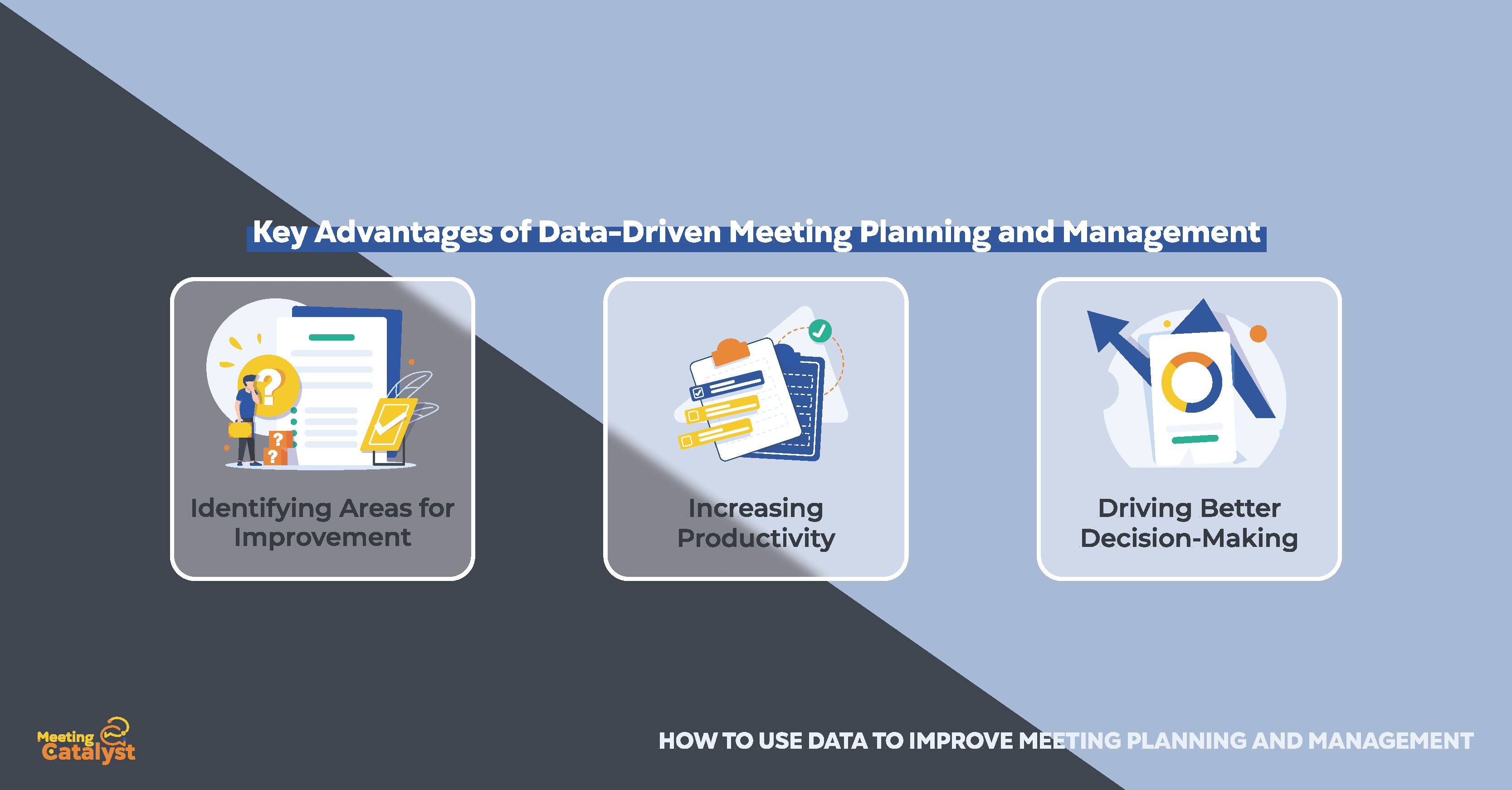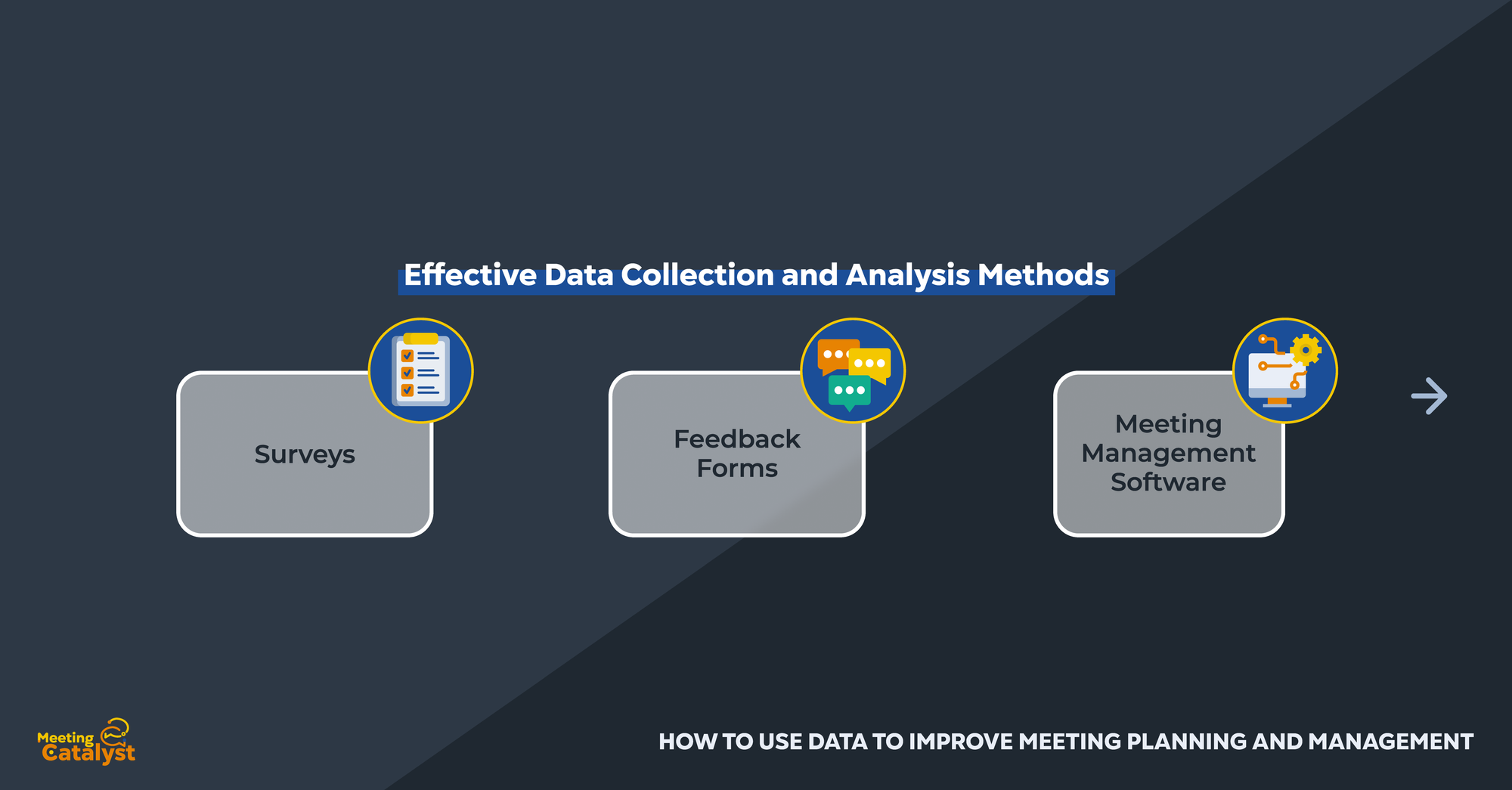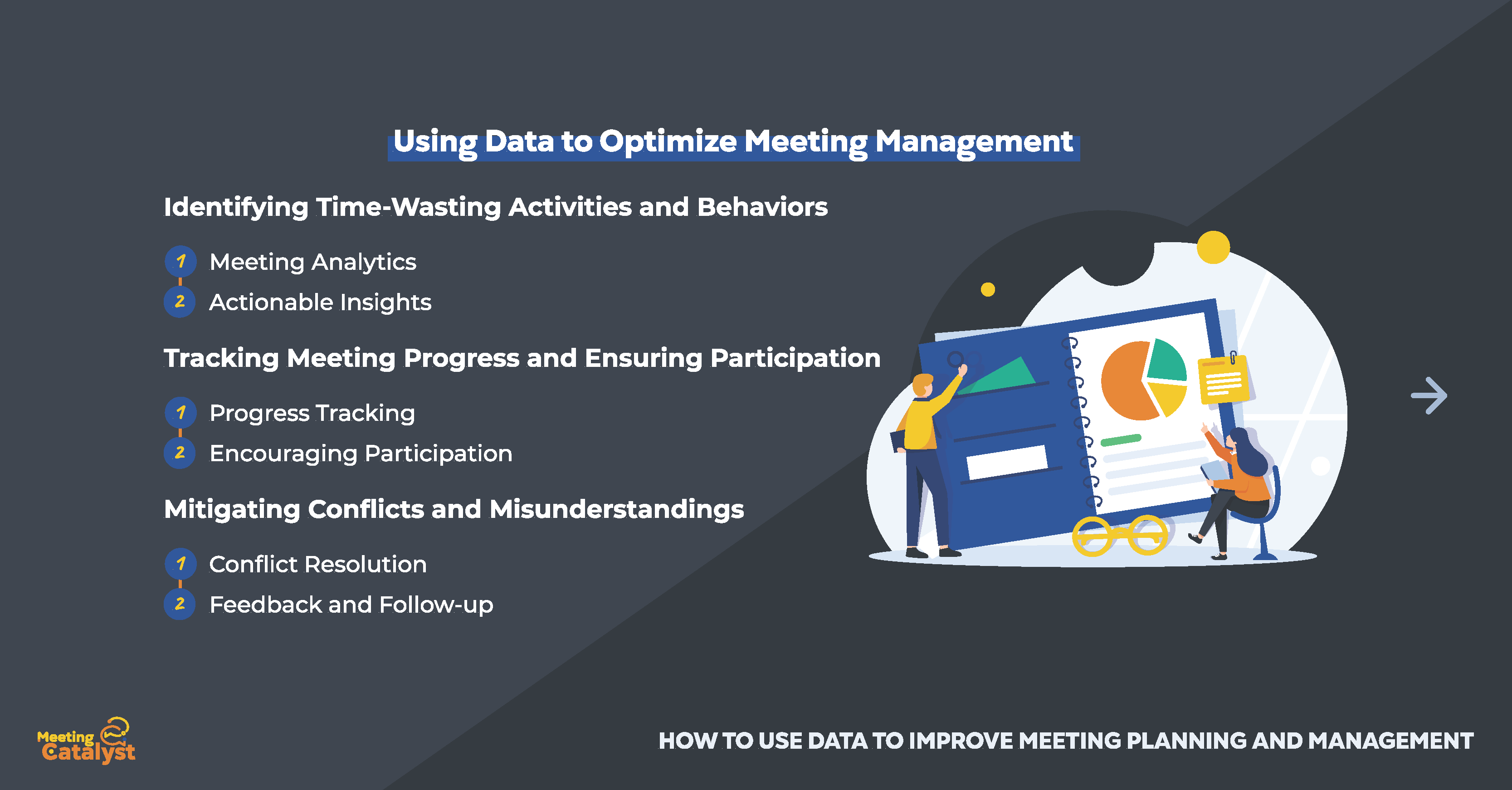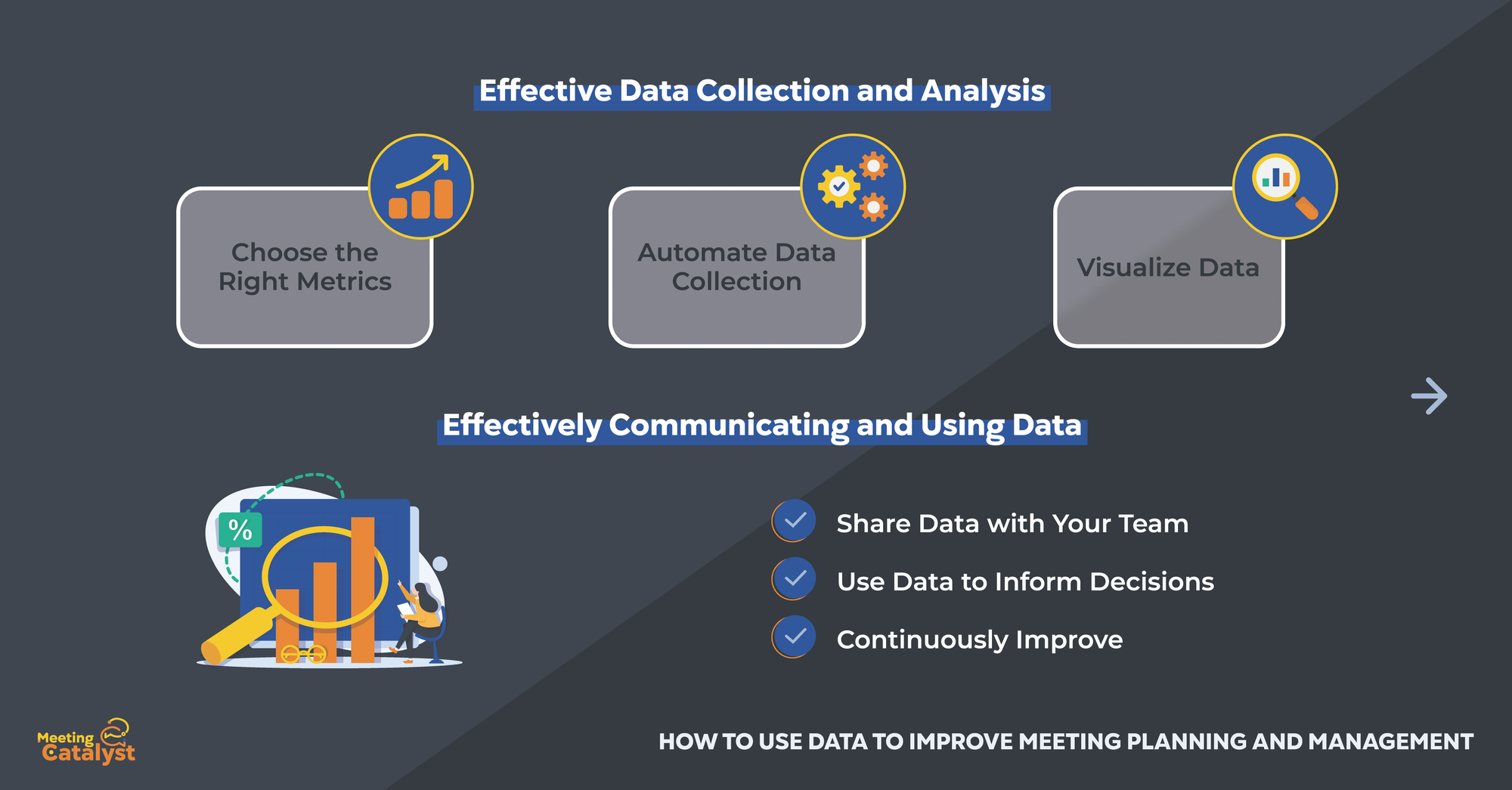How to Use Data to Improve Meeting Planning and Management

Introduction
In today's fast-paced business environment, well-organized and productive meetings are crucial for achieving success. Data-driven meeting planning and management empowers business and team leaders to make informed decisions, optimize processes, and create more effective meetings that foster collaboration and drive better results for their teams and organizations.
Preview of Key Points Covered in This Article
In this article, we will delve into the following key points related to using data to improve meeting planning and management:
- The importance of data in meeting planning and management
- Types of data to collect for meeting planning and management
- Using data to optimize meeting planning
- Using data to optimize meeting management
- Best practices for data-driven meeting planning and management
By exploring these topics, you will gain valuable insights into the power of data-driven strategies, enabling you to enhance your meetings and achieve your professional goals.
The Importance of Data in Meeting Planning and Management
Data plays a pivotal role in enhancing the effectiveness of meetings and driving better decision-making. By gathering and analyzing relevant data, leaders can gain insights into meeting performance, areas for improvement, and ways to boost productivity.
Key Advantages of Data-Driven Meeting Planning and Management

Identifying Areas for Improvement: Data helps pinpoint specific aspects of meetings that may need refinement, such as meeting duration, frequency, or attendee engagement. By analyzing data, leaders can develop targeted strategies to address these issues and improve overall meeting effectiveness.
Increasing Productivity: By understanding how time is spent during meetings, leaders can make data-driven decisions to streamline processes, eliminate unnecessary activities, and allocate time more efficiently. This leads to increased productivity and more effective meetings.
Driving Better Decision-Making: Data can uncover trends and patterns that may not be apparent through subjective observation alone. This allows leaders to make more informed decisions about meeting planning and management, ultimately leading to better outcomes for their teams and organizations.
Examples of Data-Driven Meeting Planning and Management
- A company may use data to discover that certain meetings consistently run over their allotted time. By analyzing the data, they can identify the factors contributing to this issue and implement solutions to address it.
- Data may reveal that specific agenda items or topics tend to generate more engagement and discussion. Leaders can use this information to prioritize these items in future meetings to foster collaboration and drive progress.
Types of Data to Collect for Meeting Planning and Management
Understanding the various types of data that can be beneficial for meeting planning and management is essential for creating effective strategies. This data can be collected and analyzed through a combination of methods, including surveys, feedback forms, and meeting management software.
Key Data Types for Meeting Planning and Management

Attendance: Tracking attendance data allows leaders to understand who is present at meetings and identify any trends in absenteeism or late arrivals. This information can be used to determine if meetings are scheduled at convenient times or if additional efforts are needed to ensure consistent attendance.
Duration: Monitoring the length of meetings can provide insights into their effectiveness and efficiency. Analyzing this data can help leaders identify areas where meetings may be running too long or too short, and make necessary adjustments to improve time management.
Agenda Items: Collecting data on agenda items, including the number of items, time spent on each, and their outcomes, can help leaders prioritize discussions and allocate time more effectively. This data can also be used to identify recurring issues that may need to be addressed in a different format or setting.
Action Items: Tracking action items, their assignees, and completion status can help leaders ensure accountability and follow-through on meeting outcomes. This data can also be used to assess the effectiveness of meetings in driving progress towards goals.
Effective Data Collection and Analysis Methods

Surveys: Conducting pre- and post-meeting surveys can help gather feedback on meeting content, structure, and attendee satisfaction. This information can be used to inform future meeting planning and management decisions.
Feedback Forms: Encouraging attendees to submit feedback forms following meetings can provide valuable insights into their experiences and suggestions for improvement. This data can be used to identify areas for refinement and enhance overall meeting effectiveness.
Meeting Management Software: Utilizing meeting management software can help streamline data collection and analysis by automatically tracking attendance, duration, agenda items, and action items. This technology can also facilitate communication and collaboration among attendees, leading to more productive meetings.
Using Data to Optimize Meeting Planning
Leveraging data to inform meeting planning decisions can lead to more effective and efficient meetings. By analyzing data on meeting frequency, duration, and format, as well as prioritizing agenda items and assigning roles, leaders can create well-structured meetings that drive productivity and success.
Data-Driven Decisions for Meeting Frequency, Duration, and Format
Meeting Frequency: Analyze attendance data and feedback to determine the optimal frequency of meetings for your team. This may involve adjusting the schedule to accommodate team members' preferences or finding a balance between regular check-ins and dedicated work time.
Meeting Duration: Use data on meeting length and attendee satisfaction to identify opportunities for optimization. Consider implementing time limits, focusing on specific topics, or adopting a more efficient meeting format to keep meetings on track and engaging.
Meeting Format: Evaluate feedback and performance data to determine the most effective meeting formats for your team. Experiment with different formats, such as round-robin discussions, brainstorming sessions, or presentations, to find what works best for your team and objectives.
Data-Driven Strategies for Agenda Prioritization and Role Assignment
Agenda Prioritization: Utilize data on agenda items and their outcomes to prioritize the most important topics for discussion. This can involve ranking items based on urgency, relevance, or impact, and allocating sufficient time for in-depth discussion and decision-making.
Role Assignment: Analyze data on team member strengths, expertise, and workload to assign roles and responsibilities effectively. This can help ensure that tasks are delegated to those best suited to handle them and that all team members have a clear understanding of their responsibilities.
Clear Objectives and Action Items: Use data on past meeting outcomes to set clear objectives and action items for each meeting. This will help keep meetings focused and goal-oriented, ensuring that team members leave with a clear understanding of the next steps.
Using Data to Optimize Meeting Management

Applying data-driven techniques to meeting management helps identify common time-wasting activities and behaviors while ensuring that participants remain engaged and focused. By tracking meeting progress, encouraging participation, and addressing conflicts or misunderstandings, leaders can create a more effective and collaborative meeting environment.
Identifying Time-Wasting Activities and Behaviors
Meeting Analytics: Use data from meeting management software or manual tracking to pinpoint activities or behaviors that consistently waste time. This could include excessive off-topic discussions, frequent interruptions, or lengthy debates with no clear resolution.
Actionable Insights: Develop strategies to address these time-wasting activities and behaviors, such as establishing clear meeting guidelines, setting time limits for discussions, or incorporating visual aids to maintain focus on the main topics.
Tracking Meeting Progress and Ensuring Participation
Progress Tracking: Monitor data on meeting objectives, agenda items, and action items to ensure that meetings stay on track and deliver the desired outcomes. This could involve using project management tools, shared documents, or meeting minutes to track progress and make adjustments as needed.
Encouraging Participation: Analyze data on individual participation and engagement during meetings to identify team members who may need additional support or encouragement. Implement strategies to promote active participation, such as assigning specific roles, asking open-ended questions, or using collaborative tools.
Mitigating Conflicts and Misunderstandings
Conflict Resolution: Use data on past meeting conflicts or misunderstandings to develop strategies for preventing and addressing future issues. This may involve improving communication, setting clear expectations, or providing training on conflict resolution techniques.
Feedback and Follow-up: Regularly collect and analyze feedback from team members to identify areas of concern or potential misunderstandings. Address these issues proactively, either during meetings or through follow-up discussions, to ensure that all team members feel heard and understood.
By using data to optimize meeting management, leaders can create more efficient and effective meeting environments. This not only helps to reduce time wasted on unproductive activities but also fosters a more collaborative and engaged team dynamic, ultimately leading to better meeting outcomes and overall team success.
Best Practices for Data-Driven Meeting Planning and Management

Effectively using data to drive meeting planning and management requires a combination of best practices, including proper data collection, analysis, communication, and the use of appropriate tools and software. By learning from successful organizations and individuals who have harnessed the power of data, leaders can improve their own meeting outcomes and better serve their teams.
Effective Data Collection and Analysis
Choose the Right Metrics: Focus on collecting data that is relevant to your meeting objectives and can provide actionable insights. This may include attendance, duration, engagement levels, action items, and more.
Automate Data Collection: Utilize meeting management software or other tools that can automatically collect and analyze data from your meetings. This will save time and ensure consistent and accurate data tracking.
Visualize Data: Use charts, graphs, or other visual representations to help you better understand and communicate your data findings. Visualization tools can make it easier to identify trends, patterns, and areas for improvement.
Effectively Communicating and Using Data
Share Data with Your Team: Be transparent about the data you collect and how it will be used to improve meeting planning and management. This encourages buy-in from team members and promotes a culture of continuous improvement.
Use Data to Inform Decisions: Leverage the insights gained from data analysis to make more informed decisions about meeting frequency, duration, format, and content. Data-driven decisions are more likely to lead to positive outcomes and increased productivity.
Continuously Improve: Regularly review and update your data collection and analysis processes to ensure they remain relevant and effective. Continuously look for new ways to use data to enhance meeting planning and management.
Examples of Successful Data-Driven Strategies
Company Case Studies: Research successful organizations that have implemented data-driven meeting planning and management strategies. Learn from their experiences and apply their best practices to your own meetings.
Individual Success Stories: Seek out professionals who have effectively used data to improve their meeting skills and outcomes. Connect with these individuals to gain insights and learn from their experiences.
Conclusion
Data-driven meeting planning and management is essential for business and team leaders who want to optimize their meetings, improve productivity, and drive better decision-making. By understanding the importance of data, collecting and analyzing the right types of information, and using data to optimize both meeting planning and management, leaders can unlock the full potential of their meetings and achieve greater success.
Key Takeaways
In this article, we have explored the following strategies for using data to improve meeting planning and management:
- The importance of data in meeting planning and management
- Types of data to collect for meeting planning and management
- Using data to optimize meeting planning
- Using data to optimize meeting management
- Best practices for data-driven meeting planning and management
It's time to start implementing data-driven strategies in your own meetings. By embracing the power of data, you can transform your meetings into more efficient, productive, and engaging experiences for your team. Don't wait – start leveraging data today and witness the positive impact it can have on your meeting outcomes and professional growth.